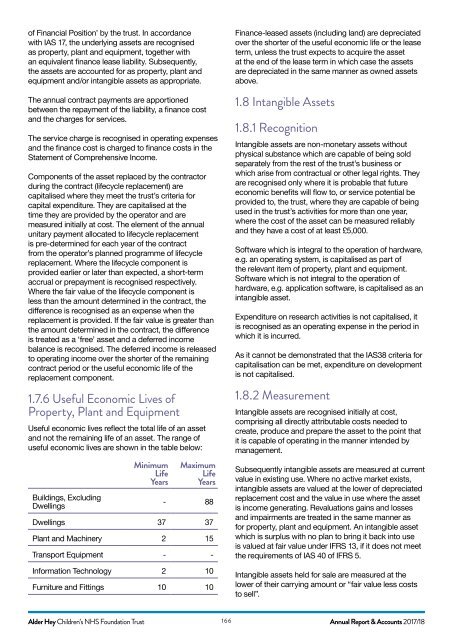AH ANNUAL REPORT 2018
Create successful ePaper yourself
Turn your PDF publications into a flip-book with our unique Google optimized e-Paper software.
of Financial Position’ by the trust. In accordance<br />
with IAS 17, the underlying assets are recognised<br />
as property, plant and equipment, together with<br />
an equivalent finance lease liability. Subsequently,<br />
the assets are accounted for as property, plant and<br />
equipment and/or intangible assets as appropriate.<br />
The annual contract payments are apportioned<br />
between the repayment of the liability, a finance cost<br />
and the charges for services.<br />
The service charge is recognised in operating expenses<br />
and the finance cost is charged to finance costs in the<br />
Statement of Comprehensive Income.<br />
Components of the asset replaced by the contractor<br />
during the contract (lifecycle replacement) are<br />
capitalised where they meet the trust’s criteria for<br />
capital expenditure. They are capitalised at the<br />
time they are provided by the operator and are<br />
measured initially at cost. The element of the annual<br />
unitary payment allocated to lifecycle replacement<br />
is pre-determined for each year of the contract<br />
from the operator’s planned programme of lifecycle<br />
replacement. Where the lifecycle component is<br />
provided earlier or later than expected, a short-term<br />
accrual or prepayment is recognised respectively.<br />
Where the fair value of the lifecycle component is<br />
less than the amount determined in the contract, the<br />
difference is recognised as an expense when the<br />
replacement is provided. If the fair value is greater than<br />
the amount determined in the contract, the difference<br />
is treated as a ‘free’ asset and a deferred income<br />
balance is recognised. The deferred income is released<br />
to operating income over the shorter of the remaining<br />
contract period or the useful economic life of the<br />
replacement component.<br />
1.7.6 Useful Economic Lives of<br />
Property, Plant and Equipment<br />
Useful economic lives reflect the total life of an asset<br />
and not the remaining life of an asset. The range of<br />
useful economic lives are shown in the table below:<br />
Buildings, Excluding<br />
Dwellings<br />
Minimum<br />
Life<br />
Years<br />
Maximum<br />
Life<br />
Years<br />
- 88<br />
Dwellings 37 37<br />
Plant and Machinery 2 15<br />
Transport Equipment - -<br />
Information Technology 2 10<br />
Furniture and Fittings 10 10<br />
Finance-leased assets (including land) are depreciated<br />
over the shorter of the useful economic life or the lease<br />
term, unless the trust expects to acquire the asset<br />
at the end of the lease term in which case the assets<br />
are depreciated in the same manner as owned assets<br />
above.<br />
1.8 Intangible Assets<br />
1.8.1 Recognition<br />
Intangible assets are non-monetary assets without<br />
physical substance which are capable of being sold<br />
separately from the rest of the trust’s business or<br />
which arise from contractual or other legal rights. They<br />
are recognised only where it is probable that future<br />
economic benefits will flow to, or service potential be<br />
provided to, the trust, where they are capable of being<br />
used in the trust’s activities for more than one year,<br />
where the cost of the asset can be measured reliably<br />
and they have a cost of at least £5,000.<br />
Software which is integral to the operation of hardware,<br />
e.g. an operating system, is capitalised as part of<br />
the relevant item of property, plant and equipment.<br />
Software which is not integral to the operation of<br />
hardware, e.g. application software, is capitalised as an<br />
intangible asset.<br />
Expenditure on research activities is not capitalised, it<br />
is recognised as an operating expense in the period in<br />
which it is incurred.<br />
As it cannot be demonstrated that the IAS38 criteria for<br />
capitalisation can be met, expenditure on development<br />
is not capitalised.<br />
1.8.2 Measurement<br />
Intangible assets are recognised initially at cost,<br />
comprising all directly attributable costs needed to<br />
create, produce and prepare the asset to the point that<br />
it is capable of operating in the manner intended by<br />
management.<br />
Subsequently intangible assets are measured at current<br />
value in existing use. Where no active market exists,<br />
intangible assets are valued at the lower of depreciated<br />
replacement cost and the value in use where the asset<br />
is income generating. Revaluations gains and losses<br />
and impairments are treated in the same manner as<br />
for property, plant and equipment. An intangible asset<br />
which is surplus with no plan to bring it back into use<br />
is valued at fair value under IFRS 13, if it does not meet<br />
the requirements of IAS 40 of IFRS 5.<br />
Intangible assets held for sale are measured at the<br />
lower of their carrying amount or “fair value less costs<br />
to sell”.<br />
Alder Hey Children’s NHS Foundation Trust 166<br />
Annual Report & Accounts 2017/18


